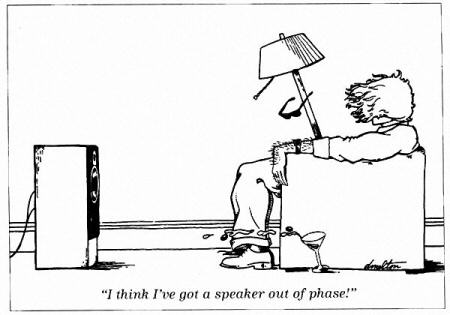
| www.ethanwiner.com - since 1997 |
Absolute Polarity & IM Distortion in the Ears
 |
I believe that IM distortion in the ear explains claims that absolute polarity is audible, as well as the "missing fundamental" principle. Absolute polarity means when you play a recording of a kick drum, for example, the speaker initially pushes outward as did the front drum head. If the playback polarity is reversed the speaker instead pulls inward, a mirror image of what the drum did. The missing fundamental concept is explained below.
In December, 2016 mastering engineer Bob Katz started a discussion on Facebook about the audibility of absolute polarity. Then Sony Oxford plug-in designer Paul Frindle created a demo based on an EQ'd sawtooth wave whose sound indeed changes when the polarity is reversed. I noticed that I could hear the polarity reversal when the volume was moderate to loud, but at very low levels the difference went away. This led me to conclude that intermodulation distortion (IMD) in the ear accounts for the change in timbre, rather than an innate ability to discern absolute polarity. The extreme EQ Paul applied made the waveform highly asymmetrical, and that flexes the eardrum differently pushing in versus pulling out. This is similar to the way loudspeaker drivers respond differently in each direction, which also makes absolute polarity seem audible even though it's really the driver's nonlinear behavior.
I decided to make some demo audio files to show by how much IM distortion in our ears affects what we hear. It's a lot! Even at moderate volumes IM difference tones are quite audible. This first demo uses 1,000 Hz and 1,200 Hz mixed together at equal volume to show how distortion in our ears creates a new phantom tone at the 200 Hz difference frequency. First 1,000 Hz is played, then 1,200 Hz, then 200 Hz at a low level so you'll know what to listen for. Finally the two higher frequencies are played together. If you listen at a moderate to loud volume you'll clearly hear 200 Hz in the fourth (last) segment even though only the two higher frequencies are actually present:
If you play the above example again very softly you'll notice that the real 200 Hz tone is present, but the phantom difference tone at the end is not. This is because our ears are more linear at low levels, just like loudspeakers and microphones. So at a very low level we hear the 200 Hz tone that's really there, but not the IMD difference tone.
To further prove the culprit is IM distortion, this second example plays the same two tones in stereo. With only one frequency present in each ear, no difference tone at 200 Hz is created within your ears. You must use headphones to prevent the tones from cross-coupling into both ears at once, and closed-back phones are best:
Now, here's where this gets even more interesting. There's a popular belief that the fundamental frequency of a musical note can be removed, and "the brain" will create a phantom fundamental pitch implied by the remaining overtones. But this too may just be IM distortion at work. Using 500 Hz as an example, the second and third harmonics are 1,000 Hz and 1,500 Hz, with all subsequent harmonics at 500 Hz intervals. But the IM difference frequency between all these overtones is the missing 500 Hz fundamental! So we do hear the missing 500 Hz fundamental, but it's created by our nonlinear hearing. To prove this, I again created both mono and stereo twin tone files, this time using 1,000 Hz and 1,500 Hz. When these frequencies are played together at a moderate to loud volume you can clearly the 500 Hz "fundamental" pitch:
But in this next stereo version, again listening with headphones, the pitch seems an octave higher because the 500 Hz difference tone is not generated by your ears:
You may have to go back and forth a few times between the mono and stereo versions to clearly hear that the stereo version doesn't include the lower 500 Hz tone.
As final proof that "the brain" doesn't synthesize a phantom fundamental, the file below plays only the odd harmonic frequencies of 100 Hz, without the 100 Hz fundamental. So all of the tones are 200 Hz apart instead of 100 Hz to avoid IM distortion in the ear creating a difference frequency at 100 Hz. The tones played in sequence are 700 Hz, 500 Hz, 300 Hz, then all three together. When all three are playing, the lowest note you'll hear is the same as the last 300 Hz tone, rather than a phantom 100 Hz fundamental.
Ethan Winer has been an audio engineer and professional musician for more than 45 years, and is co-owner of RealTraps where he designs acoustic treatment products for recording studios and home listening rooms. Ethan's Cello Rondo music video has received more than 1.8 Million views on YouTube and other web sites, and his book The Audio Expert published by Focal Press is available at amazon.com and his own web site.
Entire contents of this web site Copyright © 1997- by Ethan Winer. All rights reserved.